Quite often, instead of standard chairs, a corner sofa is installed in the kitchen, which also serves as a berth. Such designs look good not in all kitchens, as they have their own specifics.

Features
The corner sofa with a berth is ideally located in a small kitchen. The versatility and feature of the design itself makes it possible to correctly use limited space, and most importantly, to use in most cases an unused corner. Often a kitchen sofa is equipped with drawers for storing linen, utensils, or cooking accessories. Thus, just one piece of furniture makes it possible to sleep, store and eat.





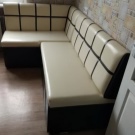
The standard length of the sofa is up to 200 centimeters, and the width when unfolded reaches from 110 to 175 centimeters, but, of course, the dimensions may vary.
The backrest in most cases is flat, tightly fixed on the wall. The presence of armrests is variable. Preference should be given to models with them only if the area allows. Choosing a corner sofa in the kitchen, it is equally important to successfully position it. The design should not interfere, but simple and easy access should be provided to it. Corner sofa is best installed near the window opposite the main kitchen.




Advantages and disadvantages
The corner sofa for the kitchen has several important advantages. The presence of boxes and other compartments, which are very easy to access, allows you to solve the issue of storage. The folding mechanism provides an additional sleeping place, which will come to the aid when guests arrive. This element of furniture is available in various sizes and shapes, and therefore it will be possible to choose the best option for any kitchen interior. Corner placement does not take away important free space, and the sofa itself is much more comfortable than standard chairs and stools.



The kitchen “corner” is very compact, and therefore it is often used for zoning the space. In principle, if you place it opposite the kitchen set, you will immediately visually be able to distinguish between the work area and the meal area, and therefore, rest. Some people prefer to unfold the sofa so that its back looks at the kitchen. In this case, again, a distinction will arise between the cooking zone and its consumption.



By the way, it is believed that the operation of this type of sofa helps to keep the walls clean.
Nevertheless, the angular design has a number of disadvantages, the main of which is the high price. In most cases, it is problematic to select a table for such non-standard furniture. If you try to save money and buy a sofa made of cheap materials, then it will suffer because of the difficult environment of the kitchen space. For example, it will absorb odors during cooking, and the upholstery may be spoiled due to dripping hot fat or increased fumes. The folding mechanism quickly fails with frequent use.
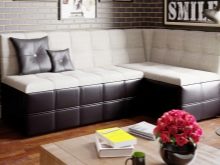
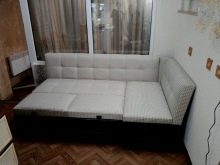
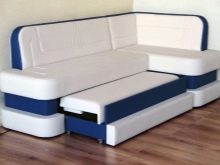
Which are there?
There are several criteria according to which corner sofas for the kitchen are divided into separate groups. First of all, this is the frame, filler and upholstery, which will be discussed a little later. Besides, the folding mechanism is also important for a folding sofa - “dolphin” or “accordion”. The first mechanism is considered more reliable and high quality. The essence of its functioning lies in the fact that the narrow part does not move, but the wide part is pulled forward.


Directly under the seat is a block that becomes an integral part of the sofa itself. The result is a wide and comfortable surface that does not occupy a large part of the room. The folding mechanism “accordion”, in fact, is a large space, so it becomes no less comfortable to relax on it. However, when unfolded, it takes up a lot of space, which forces the owners to leave most of the kitchen free to transform furniture.


Corner kitchen sofas also differ in the presence of additional functions. In this case, we are talking about the varieties of drawers, armrests, benches and, most importantly, the possibility or inability to lay out a sofa to get a berth. Each of the elements increases the cost of the product, but makes it more comfortable.
Materials and Fillers
Corner sofas in the kitchen are assembled from the frame, filler and upholstery, which, in turn, can be made of various materials. The frame is responsible for the reliability and durability of the structure; it is made of either metal or wood. The aluminum frame is light and durable, but it is quite expensive, and therefore rarely used for this type of furniture. Other metals are also not very popular, as reliability is accompanied by high cost and heavy construction. A wood frame can serve its owners for quite some time without problems if the assembly is carried out according to the instructions.

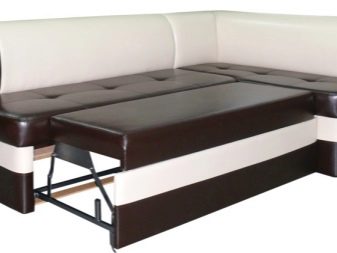
Nevertheless, it can not be called budget. It is possible to save in this case only by purchasing a corner sofa with a frame made of MDF or particleboard. The service life, however, cannot be long with a cheap product.
The filler determines how comfortable it is to use the seats. Most often, kitchen sofas are stuffed with hard material, and the back is left straight and thin. However, there are also models packed with soft polyurethane, which is often reinforced with a fibrous layer. Budget sofas are usually stuffed with foam rubber or polyurethane foam. Foam rubber fails in a few years, after which it has to be changed. Well-proven material such as holofiber. Although it resembles ordinary syntepon balls, the material does not absorb moisture, does not mold, and does not lose shape.


When choosing upholstery, it is important to ensure that it is easy to care for, it does not absorb odors and blends harmoniously into the existing interior. Upholstery made of artificial and sometimes genuine leather is considered quite popular. Its surface is difficult to stain, and care is carried out using a normal moistened cloth. Unfortunately, in hot weather, sitting on such a “corner” is not too comfortable, and it is quite expensive. Of other materials, experts recommend giving preference to a short-haired jacquard or a dense and high-quality chenille. We must not forget that it is better to choose designs with removable covers, which, if necessary, are easy to put in order in the washing machine.


Ecoskin is a very affordable material with high performance. The surface allows air to pass through due to the presence of small pores, and therefore perfectly manifests itself in the summer season. In winter, the low thermal conductivity of the material is also a significant advantage of the material. To clean eco-leather, it is enough to wipe it with a damp cloth, and remove strong dirt with ordinary soap. The disadvantage of this material is its lack of strength, since any cutting item will irreparably ruin the upholstery.


Genuine leather is more expensive than ecoskin, but it serves the owners much more time and has greater strength. However, as mentioned above, high temperatures make it difficult to use such a “corner”. In winter, in severe frosts, the skin can stiffen. Popular are modern materials that can “push out” liquids, dirt and grease that get inside. For households with pets, it is recommended to purchase sofas with the “anti-claw” effect.


Velor and velvet are not recommended for use in the kitchen, because despite regular cleaning, the materials still absorb odors. In the case when the "corner" is still regularly used for sleep, an unpleasant amber will cause a lot of trouble.
Dimensions
The corner sofa for the kitchen should be small, as its main task is to create a comfortable place to sit. The height of the back of a small module ranges from 80 to 95 centimeters, although sometimes it reaches 100 centimeters. The height of the seat ranges from 40 to 50 centimeters, and its depth reaches 70 centimeters. The length of the folding sofa ranges from 180 to 200 centimeters, but if there is no need to create an extra bed, then you can reduce it to a distance of 110-140 centimeters. Of course, the most comfortable sofa will be the one that is made according to individual parameters.


How to choose?
The choice of a sofa for the kitchen is based on several criteria. Its size should ideally "fit" into the space allocated for it, without interfering with the movement and use of kitchen equipment. Upholstery meets the basic requirements for the material, that is, it is simply cleaned and does not absorb odors. It is important to consider that the correct filler is dense and non-deformable, since this largely determines the durability of the use of the structure.


In addition, while still in the store you will have to examine the selected item from all sides to check the absence of protruding threads, inaccurate folds or other defects.
The dolphin model must necessarily have coil springs, and the accordion model must fit in the open state in a free territory. If the choice is made in favor of a model with capacious boxes for storing things, then it is better to choose a design whose lifting mechanism is located on the side. In this case, the dining table will not interfere with opening the sofa and taking out the necessary items. Since the kitchen most often represents a small room, it is better to choose bright and plain palettes that look as natural as possible.


In principle, the uniformity or presence of patterns is determined depending on the style of the kitchen interior. In the classical kitchen, both options look appropriate, models with national ornaments organically fit into ethnic spaces, and for minimalism and hi-tech it is better to choose monochrome options. A corner sofa in a room can become a necessary bright accent, so it can have any color - from red to black. It is important that the color of the sofa is in harmony with the color of the walls. Visually, furniture should not overload the kitchen, but accommodate all family members.


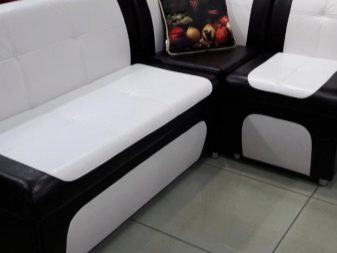

See how to choose the right corner sofa with a berth in the kitchen in the next video.










